On test: John Deere’s 6R 185 tractor
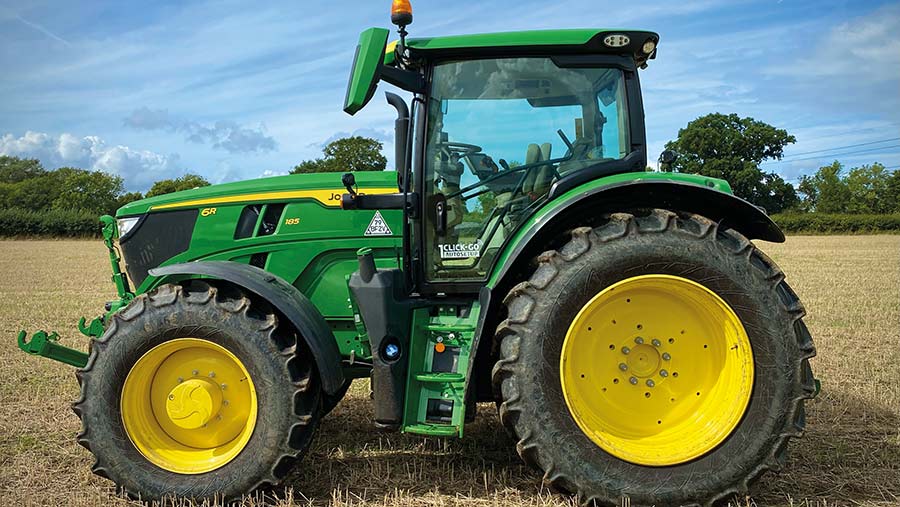 © MAG/Oliver Mark
© MAG/Oliver Mark As the UK’s most popular tractor, brands of all colours and creeds have long been gunning for John Deere’s 6R 155, but it might be some friendly fire that finally knocks it from its perch.
It comes in the form of the six-cylinder 185, one of a quartet of new 6Rs that has identical credentials to the versatile 155 – plus the added appeal of an extra 33hp.
As such, Deere reckons it’s on course to become the new number one, with keen demand, particularly from contractors, having already pushed waiting times to seven months. That’s the longest of all the 6R models and a good three months more than a bigger-framed but similarly powered 175 and 195.
See also: Video: John Deere 6120M Command Quad tractor on test
Specifications: John Deere 6R 185
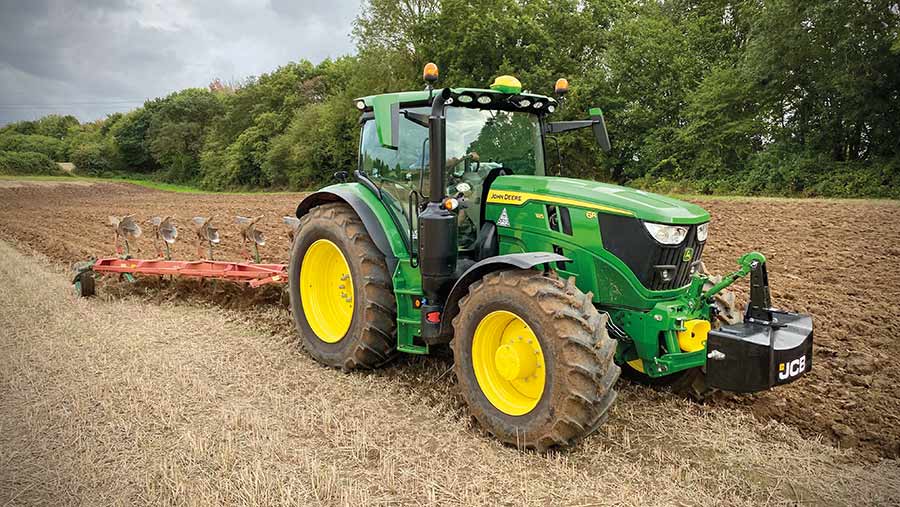
© MAG/Oliver Mark
- Engine Six-cyl, 6.8-litre John Deere PowerTech PVS
- Max power 204hp
- Max power with boost 234hp
- Max torque 866Nm@1,600rpm
- Max torque with boost 941Nm
- After-treatment EGR, DPF, DOC, SCR
- Diesel tank 280/322 litres
- Transmission AutoPowr CVT, 50kph
- Weight 7,900kg
- Wheelbase 2.77m
- Max tyre size 710/70 R38 rear, 600/65 R28 front
- Hydraulics 155 litres/min, up to six spools
- Rear lift 8,100kg
- Max permissible weight 11,750kg
- List price, as tested £230,478
- Base list price £171,159
The appeal is obvious. Its weight and wheelbase makes it a practical all-rounder, but it packs much more power into its mid-sized frame, boosting to 234hp for high-speed transport, pto work and, for the first time, hydraulic applications.
Much like the enduringly desirable 155, it’s cheaper to buy and run than a large-frame 6R tractor (175, 196, 215, 230 and 250), and shouldn’t depreciate as quickly, either. Yet it will be more comfortable on triple mowers, trailers, tankers and big balers – the sort of tasks that can have 155s on their knees or the engine’s thermostat begging for mercy.
But there’s a catch. Lift capacity remains a relatively modest 8t, so those with heady ambitions of pushing their performance to new heights might have to think again.
More power… but anything else?
The development of the 185 centred on a retune of the 6.8-litre Powertech engine. As well as the extra power, Deere has widened the availability of the boost function (IPM in Deere parlance).
On previous 6Rs, this was dished up when the tractor reached its maximum power at high speed or while the pto was engaged, but use of the 155-litre/min hydraulic system – either through the spools or Power Beyond connection – also now brings the boost into play.
That means the tractor can tap into the extra 30hp for a wider variety of work, such as maintaining fan speed on a pneumatic drill when the engine is working hard.
The same might also apply for spraying, where performance would otherwise be affected when the tractor reaches its maximum power.
The operator doesn’t get a say on which element – forward speed, pto speed or hydraulic output – is the priority, though. It is determined by the tractor.
One other significant improvement is the £2,600 option of a reversible cooling fan, which may go some way to remedying the tendency of 6Rs to get hot under the collar when toiling with a set of triple mowers.
The sealed unit is different to the standard offering and is mechanically driven, which means it takes a couple of horsepower to run. As such, it should only be specced if necessary, says Deere – though it’s worth bearing in mind that it can’t be retrofitted.
It’s engaged for a five-second stint via a manual switch on the steering column, so there is no means of setting it to automatically reverse at predetermined intervals. However, it’s a neater arrangement than the aftermarket solution many customers previously opted for.
The rest of the powertrain is largely as before, including the exhaust after-treatment system. Unlike much of the competition, Deere has stuck with exhaust gas recirculation, combined with a particulate filter, DOC and SCR.
This keeps AdBlue consumption relatively low – evidenced by its modest 16-litre tank – but adds a little more complication.
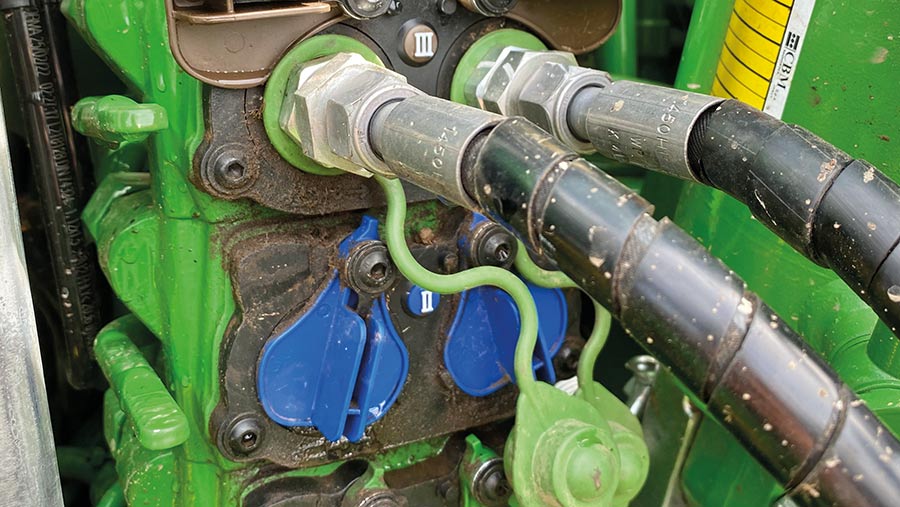
© MAG/Oliver Mark
Solitary transmission
While other 6R models have at least two gearbox options, including Deere’s ubiquitous AutoQuad and, in some cases, the sharp-shifting DirectDrive, 185s are only available with the ZF-built AutoPowr CVT.
This is unlikely to be a big issue for most, with CVTs now dominating 6R sales.
The gearbox uses at least 60% mechanical power at any given speed, rising to 100% at four set points – 3.5kph, 11kph, 22.5kph and 47.2kph.
Transmission power losses are lowest at these peaks, so it is worth bearing in mind when setting target speeds.
Power take-up is incredibly smooth and it’s impossible to notice the changes as the hydrostatic element drifts in and out through the four imperceptible ranges.
It’s good on fuel too, delivering the best sub-250hp fuel efficiency stats on the road in the DLG’s (German Agricultural Society) Powermix transport test.
As for running gear, there are new cab suspension mounts that make for a less-wallowy ride, combined with the firm’s Triple Link Suspension Plus setup on the front. Buyers can also opt for a quick-steer function (£321) and heavy-duty rims for fitting wheel weights or duals.
Hydraulic cab suspension (£2,500) is a popular extra, as are 650/65 R42 rear tyres and the Fancy Ultimate seat, at £1,000 over the Premium version.
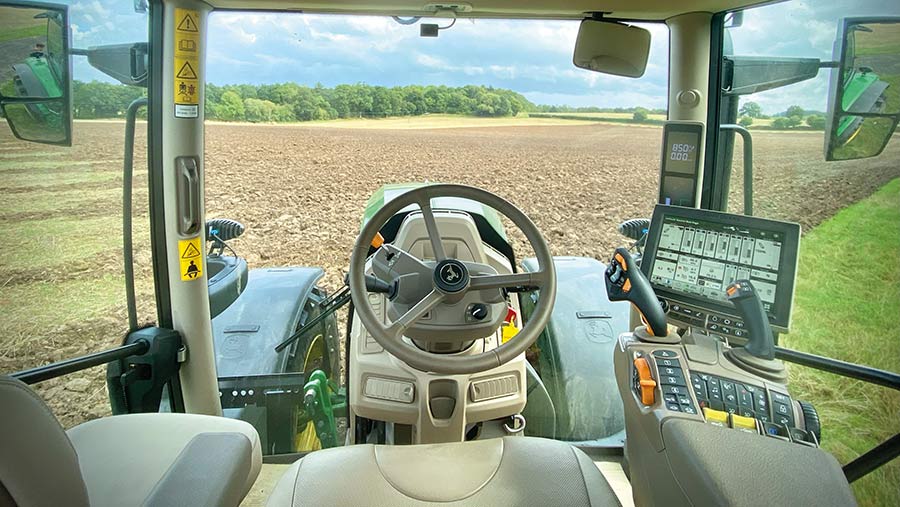
© MAG/Oliver Mark
What about the cab?
The cab frame is a remnant of the initial 6R launch in 2011, but has since gained the Command Pro joystick (2018) and several other improvements that mean it is still one of the best on the market.
Space, light and storage remain abundant, the screen is easy to use and the controls are obvious.
The only exception is the spools, with the paddle for the first valve located at the front of the armrest and too easy to muddle with its neighbour, which manages the linkage raise and lower. A conventional bank of spools would be nice, though terribly old-fashioned…
The stand-out change to the latest models is the dash, with the traditional binnacles ditched and read-outs shifted to a high-definition display on the A-pillar – much like the increasingly popular, and less fancy, M-series.
It’s a neat setup, keeping the information in the driver’s line of sight, and leaves nothing but a phone holder and some air vents behind the wheel.
There’s also a new electronic auxiliary joystick for controlling the hydraulics and Isobus functions, plus the forward/reverse shuttle.
It can be used with a new range of R-series loaders developed specifically for the 6Rs. These come with plenty of gizmos, including a return-to-position function, on-the-move load weighing and “level to horizon”, which maintains the angle of the headstock as the tractor rides over uneven ground.
Beyond these updates the changes are pretty minor. There’s a new front window wiper that will swipe through 270deg (much like a Fendt or Valtra) and the exterior styling has filtered down from Waterloo-built 7R, 8R and 9R tractors – including a sloped bonnet, sleeker appearance and some expensive-looking electric wing mirrors.
Deere has also sorted Bluetooth connection problems between the driver’s phone and the hands-free media system. But in doing so, it’s no longer possible to control music, podcasts or phone calls through the armrest touchscreen, which seems a retrograde step.
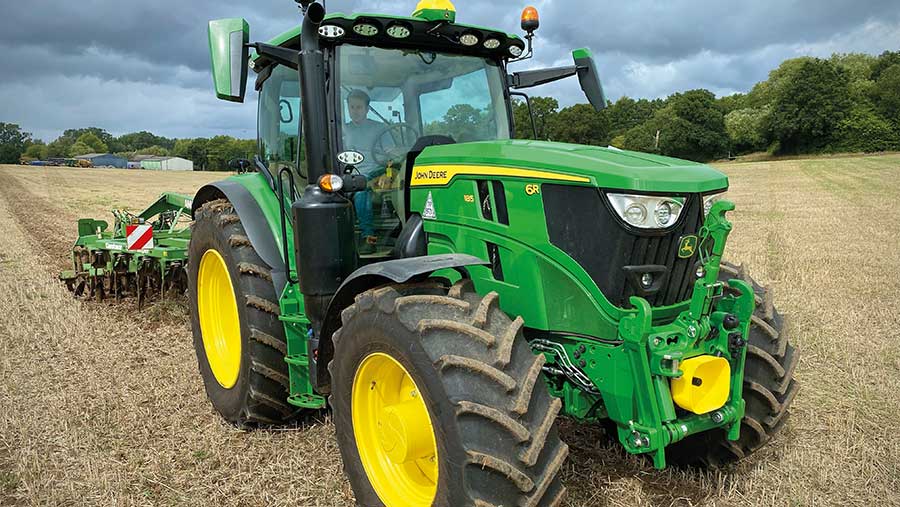
© MAG/Oliver Mark
Extra tech
The company has long been pushing the merits of its JDLink telematics offering, which has now morphed into the 1-Click-Go-Autosetup system. This allows managers to assign jobs from the office via Deere’s Operations Center, reducing the amount of time it takes to get the tractor – or combine, forager or sprayer – set up in the field.
Once the work plan is sent, it automatically pops up on the Gen4 screen when the machine crosses the field boundary and, as the name suggests, is engaged with a single click.
With it comes maps, obstacles, guidance lines and prescriptions, plus any programmed widths or offsets for the implement – saving a whole lot of button-pushing in the process.
Various paid-for unlocks add AutoTrac turn automation, implement guidance, section control and Machine Sync, which synchronises the tractor speed with that of a forager or combine.
However, unlike the 7Rs, it’s still not possible to get the Starfire receiver integrated into the roof.
This will be a major frustration for many – particularly given they are rural thieves’ favourite prey, stand out like a beacon on the top of the tractor, and are a right pain in the backside to fit and remove every day.
Though the process of locking them to their mounting bracket is easy, Deere could at least simplify the climb up by providing a proper step and platform above the fuel tank – particularly for stiff-jointed drivers.
The company says it is working on the traceability of receivers but, for now, the only protection is through a four-digit pin – which won’t necessarily stop them getting pinched in the first place.
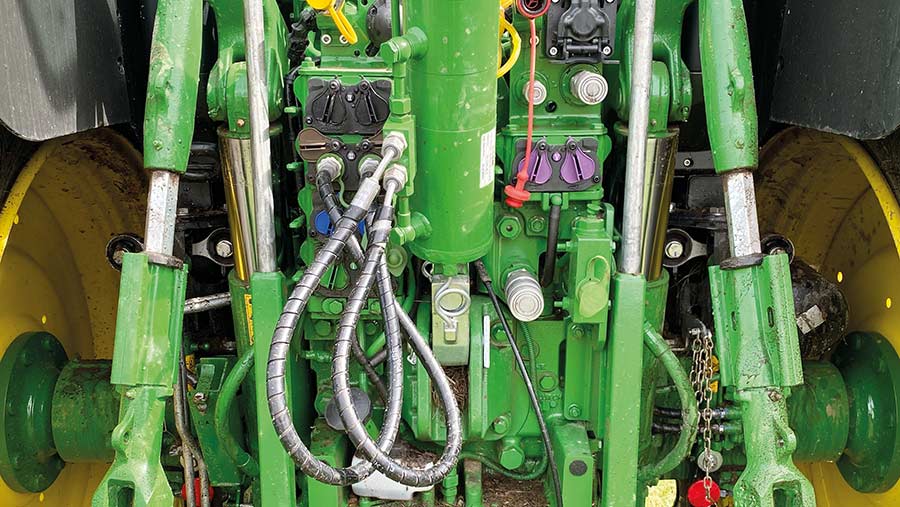
© MAG/Oliver Mark
FW verdict
On paper, the 185 looks just the ticket for 6R 155 owners who are pushing their machines to the limit. Based on that, there’s not a whole lot to dislike – the 155 is popular for a reason.
However, it’s a power upgrade that doesn’t come cheap, with a difference in list price between the two of approximately £10,000.
That makes it significantly more expensive than remapping an older model through a third-party tuning firm – albeit without the risk of invalidating the warranty.
For now, Deere has taken the sting out of that upgrade by offering some pretty keen deals, though there’s no guarantee of these lasting permanently.
There are cheaper alternatives out there too, including the likes of Massey Ferguson’s 7S.210, which has more rear lift capacity, or the New Holland T7.225. And it remains to be seen how Fendt follows up its 700-series rejig, which could see more competition coming to the 200hp sector.
Likes and gripes
✔ Smooth power take-up
✔ Reversing fan option
✔ Clear A-pillar display
✔ Neat second joystick with plenty of functions
✘ No option for integrating Starfire receiver into roof
✘ Media/phone no longer controlled through screen
✘ Complex emissions system
✘ No timer option for reversing fan
The range
It has been 10 years since the 6Rs replaced the iconic 6000-series, and there are now 14 models offering a broad range of power outputs, wheelbases and carrying capacities.
At the base is a gang of five “small-frame” tractors that run 4.5-litre, four-cylinder engines and have 2.58m wheelbases. They start with the 121/135hp 6R 110 and are topped by two newcomers to that sector – the 140 (154/166hp) and 150 (165/177hp).
These models enter new territory for Deere, which hadn’t previously dabbled in the high-horsepower four-cylinder market, but decided to act in response to continuing demand for the likes of Valtra’s Ns, New Holland’s T6s and the Massey Ferguson 6S.
The “mid-frame” six-cylinder range also includes a brace of newcomers. Based on a 2.77m wheelbase, the 6R 145 (160/195hp) and eternally popular 155 (171/203hp) remain largely as before, but above them come a 165 (182/213hp) and the 185 (204/234hp).
“Large-frame” 6Rs – the 175 (193/223hp), 195 (215/244hp) and 215 (237/259hp) – have a 2.8m wheelbase, while the “xtra-large” 230 (253/281hp) and 250 (275/301hp) stretch to 2.9m. These run the same 6.8-litre six-cylinder as the mid-rangers.
*Figures relate to max/boosted power

